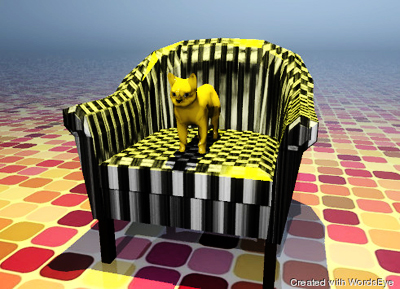Student-led Social Media Startup Wins Grand Prize in Statewide Competition
The old adage, “a picture is worth a thousand words,” is particularly fitting for the creators of WordsEye.

This WordsEye image was generated from the following text: "The orange cat is on the chair. The chair is white. The ground has a design texture. The ground is shiny. The huge yellow illuminator is 7 feet above the cat."
The text-to-image software startup, co-founded by computer science PhD candidates Bob Coyne and Daniel Bauer, recently won the grand prize—a $100,000 award—at the Fourth Annual New York Business Plan Competition. WordsEye bested more than 430 teams from nearly 60 colleges and universities statewide in the competition, sponsored by the State University of New York’s College of Nanoscale Science and Engineering (CNSE) to support high-tech education and entrepreneurship amid the state’s thriving technology scene.
The WordsEye team, which also includes Columbia Business School student Neelam Brar, intends to use the award money to further develop its proprietary software, which the team describes as “Twitter meets Instagram.” WordsEye’s technology, geared toward social media users, provides a new medium for visual expression, allowing users to create 3D scenes or images simply by text descriptions.
“The goal of WordsEye is to help people express themselves in visuals as quickly and easily as they can with language,” says Coyne. “It took a while for the news to sink in. Our next step is to get financing to actually launch the business.”
The team’s momentum is in overdrive, having been in the works over the past several years. Coyne says they are already talking to several potential investors, plan to participate in more pitch events, and aim to beta test the software this summer.
The team has already gained interest from the educational sector. The software can be used for vocabulary building, literacy, special needs instruction, cyber arts, and storytelling. “We tested WordsEye with sixth-grade students in an enrichment program a couple of summers ago at Harlem Educational Activities Fund,” says Coyne, “and found that students using it improved more significantly in their tested literacy skills as compared with a control group.” Down the road, the team will look into applying WordsEye to 3D games.
Julia Hirschberg, professor and department chair of computer science, is Coyne’s faculty adviser and has been involved early on in the making of WordsEye. With Columbia Research Scientist Owen Rambow, and Richard Sproat (now at Google), Hirschberg helped secure funding from the National Science Foundation to conduct additional research on WordsEye and get the product where it is today.
“Now we’re at the stage where WordsEye can be made widely available, through social media,” says Hirschberg. About the significance of the software, she remarks, “Being able to draw beautiful pictures using regular language seems like magic to WordsEye users, even though it's based on a great deal of very sophisticated language processing technology.”
Coyne got the idea for WordsEye after his then two-year-old son woke him in the middle of the night and he was unable to get back to sleep. He had been developing a commercial 3D graphics system at the time and felt frustrated that he never had the time to actually use the system himself; the system was flawed in that it was too laborious and time consuming.
“I wanted to much more easily translate my own artistic ideas into actual scenes. It occurred to me that language would let me do that,” recalls Coyne. “By using language you give up some amount of control over details but you gain in expressive power.”
WordsEye’s primary focus is social media, as a tool, adds Coyne, “to let everyone create pictures that they can share. With WordsEye, people won’t have to spend months learning complex tools and hours using those tools in order to create beautiful rendered 3D scenes.”
